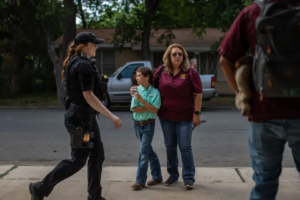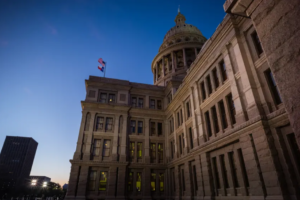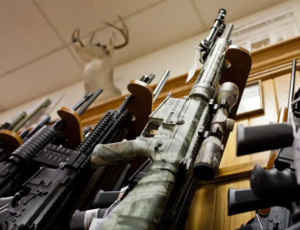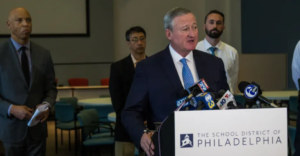After seven years, Pennsylvania’s landmark school funding case is set to go to trial on Friday, giving educators and parents in low-wealth districts the opportunity to tell the court how students are harmed by a system that has resulted in some of the widest spending gaps among better-off and poor districts in the country.
“The case is important because the Pennsylvania legislature has for more than a generation been ignoring its duty to make sure students have the resources they need to learn and be effective citizens of the Commonwealth,” said Michael Churchill of the Public Interest Law Center, which along with the Education Law Center and the private firm O’Melveny is arguing the case. “On their own, the legislature will not take care of the most basic needs that Pennsylvania has.”
The case was originally filed in 2014 on behalf of six school districts — urban, suburban and rural, including the William Penn district that abuts southwest Philadelphia. Three families, including one from Philadelphia, are also plaintiffs, as are two statewide advocacy groups – the Pennsylvania chapter of the NAACP and the Pennsylvania Association of Rural and Small Schools, or PARRS. It will be tried before Commonwealth Court Judge Renée Cohn Jubeliler in Harrisburg.
At issue is whether the state is providing enough money to adequately educate all its students and whether the funds are distributed equitably based on the needs of districts.
“We are asking for substantial new investments in state funding for public education, distributed based on need, so that local wealth will no longer be what determines if Pennsylvania students can receive a quality public education,” said Deborah Gordon Klehr, executive director of the Education Law Center. “The specifics of this new system will be up to the state legislature to determine, under the oversight of the court order. We are not seeking a specific dollar amount or method of funding schools.”
The School District of Philadelphia is not part of the case – it was under state control when it was filed – but Superintendent William Hite is expected to be among the witnesses in a trial predicted to last eight to 10 weeks. Hite and other District officials have said that they are counting on this case to bring more money to district schools, which struggle to educate some of the state’s neediest students with a per-pupil expenditure that is far below its many of its wealthier suburban neighbors.
Besides William Penn, the plaintiff districts are Lancaster, Wilkes-Barre, Greater Johnstown, Panther Valley, and Shenandoah Valley. They have diverse student populations that are mostly low-income, and limited taxing capacity of their own to raise sufficient funds for schools.
The plaintiffs argue that the current funding system violates the state constitution’s mandate for a “thorough and efficient system of education,” as well as its equal protection clause. They say the legislature’s own analysis shows a statewide adequacy shortfall of $4.6 billion.
“In the six-plus years since the Petition was filed, Respondents have done nothing to turn around what is indisputably a failing system,” the plaintiffs’ pre-trial brief says. “Instead, Respondents have exacerbated or ignored the endemic funding shortfall and entrenched inequities, with disastrous results for Pennsylvania’s children.”
The brief notes that 44% of third graders fail to meet state proficiency standards in math, and 38% fall short in English. High school achievement in math and English, as measured by state tests, show more than a third failing to meet standards.
And the results in poor districts are worse.
“By every measure, the results are far more disastrous for low-wealth school districts, and the economically disadvantaged children they educate,” the brief says. “Compared to their more fortunate peers, those children are less likely to be proficient on state exams from the first moment they are tested to the last.”
In their pre-trial brief, attorneys for House Speaker Brian Cutler argue that school funding is a matter of public policy, not judicial interference.
“Petitioners’ grievances consist primarily of public policy disagreements with the decisions made by Pennsylvania’s elected representatives. In an effort to elevate these routine policy disputes to constitutional significance,” the plaintiffs “misleadingly attempt to create a dystopian view of Pennsylvania’s education system,” the brief says.
Cutler’s attorneys say that on average, Pennsylvania’s students outperform peers in most other states and have a high college completion rate. Citing census data showing that the state ranks sixth in total per-pupil revenue, Pennsylvania “outspends most of its sister states,” and “districts are clearly providing opportunities for their students,” the brief says.
While acknowledging that there are spending gaps among districts, and that the current system “isn’t perfect,” the brief says that the state constitution “does not require a public school system that is beyond criticism. Nor does it require the General Assembly to cure all of the economic, social, community, family, and personal factors that cause students – and subgroups of students – to succeed at different rates.”
In their pre-trial brief, attorneys representing Senate President Jake Corman downplayed the role of funding in assuring a quality education.
“This case is replete with social issues and murky questions of how to determine if a school is doing a good job,” and “whether the school’s performance is tied to its funding,” the brief says. “Moreover, there are significant problems with Petitioners’ theory of causation, which rests on the belief that simply providing more money to schools will lead to greater academic success.”
Plaintiffs “ignore the reality that student results are not the same as student opportunities, and assume that school districts are spending their funds in a wise and efficient manner.”
Most states fund schools primarily through local property taxes, which gives an advantage to richer districts. State dollars, and some federal aid through programs like Title I, which provides funding for low-income students, are meant to compensate for inequities. But these dollars rarely make up all the difference.
Over the years, similar legal challenges have been brought in about half the states with varying results.
Pennsylvania “has long been one of the least equitably funded state school finance systems in the country,” said Bruce Baker, a professor of education at Rutgers University and a national expert on school funding. And Philadelphia “has been one of, if not the, least adequately funded major urban district.” Baker has testified in other states’ funding cases, but is not involved in this one.
The average per-pupil expenditure across the Commonwealth puts Pennsylvania in the top 10 among states, he noted. “But a lot of that is driven by the relatively high expenditures in the Philly suburbs in particular.”
He also said that while student test scores across the state are good on average, “the inequities are huge, and they have systematically fallen on certain types of districts over time.”
According to an interactive tracker that Baker helped create, some of the most underfunded districts in the country compared to need are small Pennsylvania cities, such as Allentown and Reading, which fare even worse than Philadelphia, he said.
“We should be funding at a higher level places with greater needs,” Baker said. But that is not, for the most part, how the state-based system in the U.S. works. “Instead of having more, in Pennsylvania in particular they have a lot less,” which impedes students’ ability to succeed, he said.
This is not the first case in Pennsylvania brought by advocates seeking to overturn the funding system – PARRS filed a case 30 years ago, and Philadelphia filed its own lawsuit several years later.
In those cases, Pennsylvania’s courts ruled that school funding is a matter for legislators, not judges, to decide. That stance contrasts with other states, including neighboring New Jersey, where the courts have ordered the legislature to direct more money to poor, underfunded districts in cases starting with Robinson vs. Cahill in 1973, and culminating with the state Supreme Court decision in Abbott v. Burke.
In that case, the court ruled in 1990 that its method of funding schools violated its “thorough and efficient” clause in its state constitution and ordered more funds sent to 28 poor urban school districts, including Camden and Newark.
“While courts in the rest of the nation have been wrestling with this problem since the 1970s, and have had great results as seen in neighboring state of New Jersey, Pennsylvania courts refused to look at this question for many years,” Churchill said.
That changed in 2017, when the Pennsylvania Supreme Court reversed itself and said that this case could go to trial.
The defendants include the General Assembly, Gov. Tom Wolf and the state Department of Education. But only the Senate and Assembly leaders are mounting a strong defense of the current system in court.
Wolf, a Democrat, campaigned in 2014 on the platform of sending $1 billion more in state aid to schools, but the Republican-controlled legislature never agreed to hikes that big. And while lawmakers revised the formula for distributing state education funds in 2016 to account for special district circumstances, including poverty, the legislature has not applied the new formula to most of the aid, only to new dollars.
This article was originally posted on Landmark Pennsylvania fair school funding case set for trial






Be First to Comment